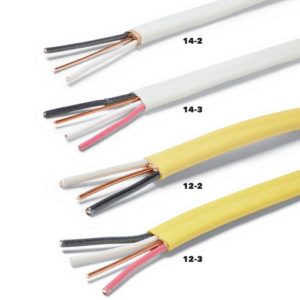Are you in the market for a new outlet? If so, you may wonder what the different 14/2 and 12/2 options are. Here’s a breakdown of the two options, and what each one is best for. Ready to make a decision? Read on to find out!

The physical size of a wire is referred to as its wire gauge, which is also a numerical designation. The bigger the wire gauge number, the smaller the wire diameter.
The circuit breaker may influence the choice of wire gauge for an outlet. Using a 14 gauge wire isn’t a bad choice if the circuit breaker is a 15-amp breaker, but it’s the best option if it’s a 20-amp breaker. Because it has a wider diameter and cross-sectional area, a 12 gauge wire cable is usually used when wiring an outlet.
Table of Contents
14/2 or 12/2, Which Gauge Wire is Thicker?
The thicker the gauge number, the thinner the wire, according to the American Wire Gauge (AWG) standard. A 12 gauge wire is roughly equivalent to nickel in thickness, whereas a 14 gauge wire is equal to a dime.
As a result of this comparison, A 12-gauge wire is unquestionably bulkier than a 14-gauge wire. Because of its smaller cross-sectional area, a smaller wire generates more resistive heat. As a consequence, when it’s being utilized for a longer time, it can only handle so much current.
A larger diameter wire is referred to by a lower gauge number. The term gauge refers to how many cables can be squeezed through a typical aperture.
What is the Thickness of 12/2 Gauge Wire?
The 12/2 gauge wire is thicker because it has a thickness that is 26% greater than the thickness of the 14 gauge wire. A 12/2 AWG wire has a diameter of 0.0808 inches or 2.05mm, whereas a 14 AWG wire has a diameter of 0.0641 inches or 1.63mm.
The insulation of a 12/2 gauge wire, on the other hand, determines its thickness. Since of their cheap cost, PVC or polyester are the most often used in materials for insulation. PVC insulation is normally half an inch thick, while polyester insulation may be up to an inch and a half broad.
Wire insulation tries to safeguard the electric current from inside a wire by holding and enclosing it together.
12/2 gauge wire, for example, has a diameter of 2.05mm and is encased in insulation. If you’re unsure which wire to use in a circuit with both lights and outlets, 12/2 gauge wire is the best option.
On a 15 or 20-amp circuit breaker, it is thicker and costs a bit more, but it is always a safe choice. As far as you’re concerned, using a 12/2 gauge wire throughout your home is not a mistake.
What is the Thickness of the 14/2 Gauge Wire?
A paperclip is roughly the same thickness as a 14/2 gauge wire. It isn’t possible to define a particular thickness for 14/2 gauge wire. A 15-amp circuit breaker can be a wire with a thickness of 1.63mm and a diameter of 1.63mm.
For more than a century, the American Wire Gauge (AWG) system has been used to determine cable thickness. Wires are classified by size rather than thickness in this method.
16 AWG, 12 AWG, 10 AWG, 8 AWG, and 6 AWG are the most popular wire sizes for electric circuits that do not exceed the recommended maximum amperage ratings.
The number of strands bundled together in one inch is used to determine thickness, whereas thousandths of an inch are used to determine thickness.
Do outlets need to be put on 12/ Gauge Wire?
A 20-amp circuit should be able to support as many outlets as you need without jeopardizing the breaker when nothing is connected. The number of outlets is limited in practice. Yet, a 12/2-gauge wire with a 20-amp circuit breaker has ten outlets in actuality and is permitted by code.
Electrical panel circuit breakers are safety devices that you’ll find in your house. Each of these devices is designed to cut off electricity whenever the current in the circuit reaches its rating. To avoid overheated cables, surges, and fires, it comes to a halt.
- You should know how many outlets you have and how much power they consume.
- A 20-amp circuit breaker can deliver up to 16 amps of power, which is the greatest amount allowed.
- The power draw must reach 2,400 Watts for a standard circuit breaker to trip.
Outlets need to be put on 14/2 Gauge Wire
In this way, the circuit breaker can withstand the sudden surge when you turn on equipment such as a power saw or an air conditioner for the first time, according to the NEC recommendation.
As a result, under this restriction, only eight outlets are permitted on a 14 gauge wire. Connecting a 14-gauge wire to a 15-amp circuit breaker is merely permissible in a practical sense.
Circuit breakers must be able to accommodate at least 80% of the load they were designed for, according to the NEC.
- A circuit can only handle a maximum of 12 amps of current.
- The number of fixtures required is determined by the amperage draw of a fixture.
- To keep a light lit for three hours, you’ll need a 15 amp breaker.
To find the total fixture, you would have to calculate each fixture’s current draw.
What’s the use of a 12/2 Gauge Wire?
For a 12 gauge wire, there’s no particular equipment you can use. Kitchen utensils, bathroom, outdoor receptacles, and 120-volt air conditioners supporting 20 amps may all be used with a 12 gauge wire.
When connecting to a specific height, you may use a 12 gauge wire on a 15-amp circuit breaker for up to 70 feet. On a 20-amps circuit breaker, the peak falls to 50 feet.
The wire must be able to lower resistance while simultaneously increasing transmission performance, as reflected by the gauge of the wire.
What’s the use of a 14/2 Gauge Wire?
For lights, light fixtures, and lighting circuits connected to a 15-amp circuit breaker, use a 14 gauge copper wire. Remember, as previously mentioned, that you must also decide on the number of connections to make.
The cable cannot keep a big device in place for a long period because of the 14/2 gauge wire flexibility. Furthermore, because a standard 14 gauge copper wire has a diameter of 1.63mm, handling more current creates more resistive heat and overheating.
Conclusion
You should ensure the circuits are not connected when installing your home. This will allow all of the lights to be affected at once by a power outage. You may also utilize a 15-amp circuit breaker 14-gauge wire since you don’t add too many lights to the light circuit.
A 12 gauge wire is best for an outlet that includes lighting, while a 14 gauge wire is best for lighting only on a 15-amp circuit breaker.
